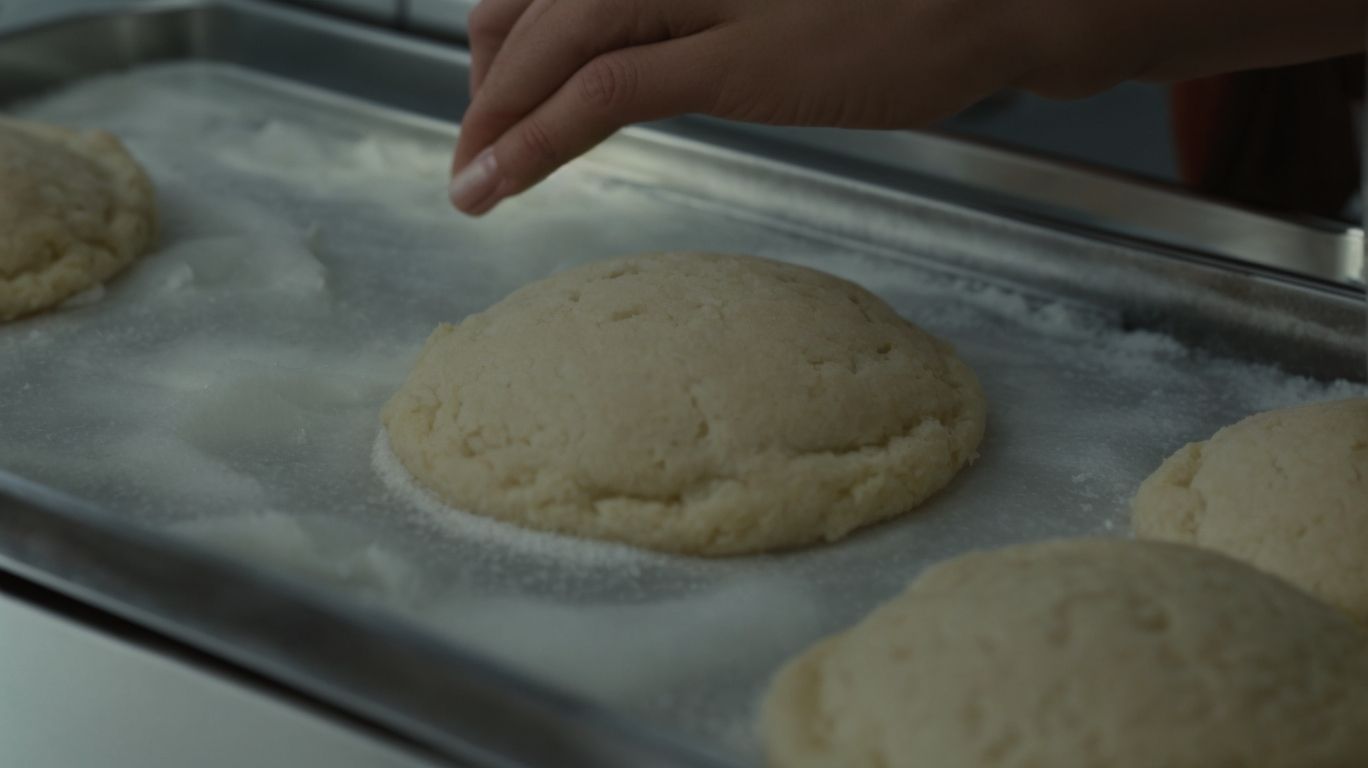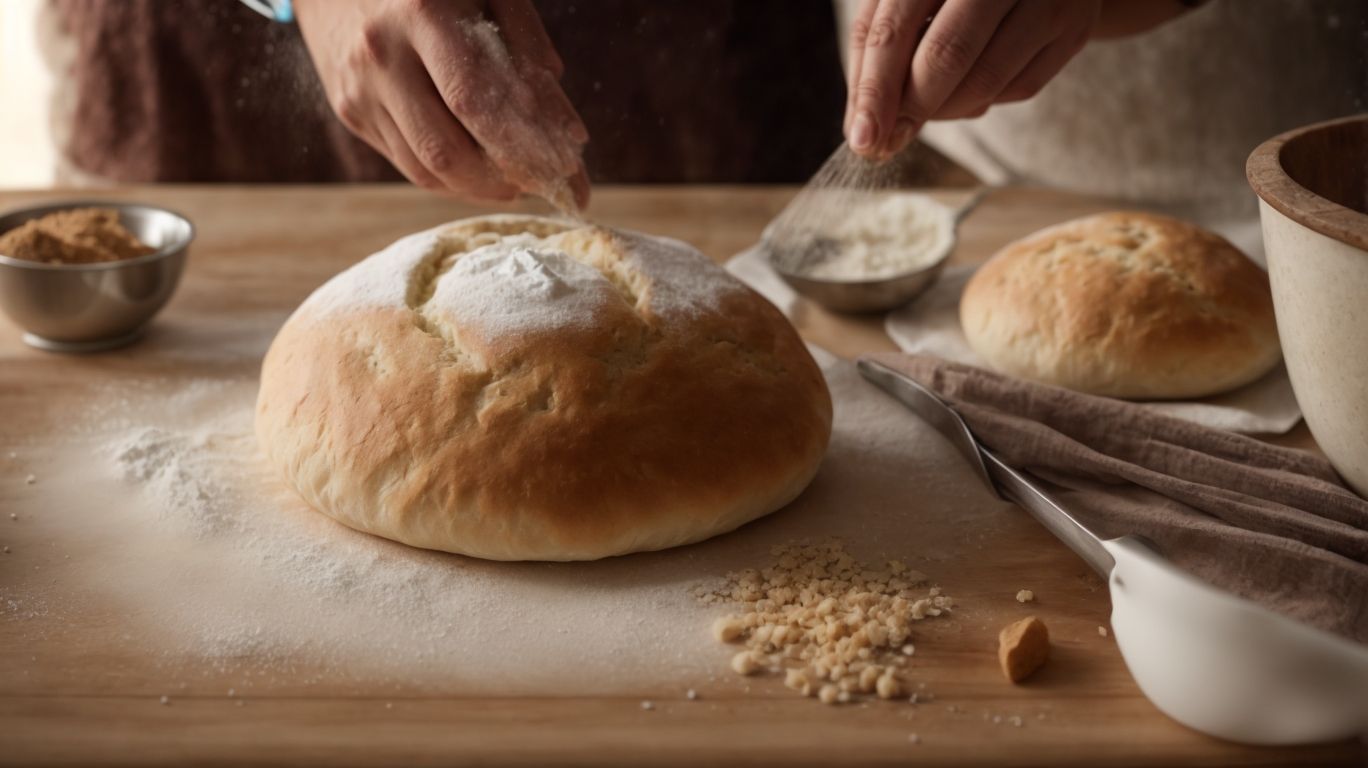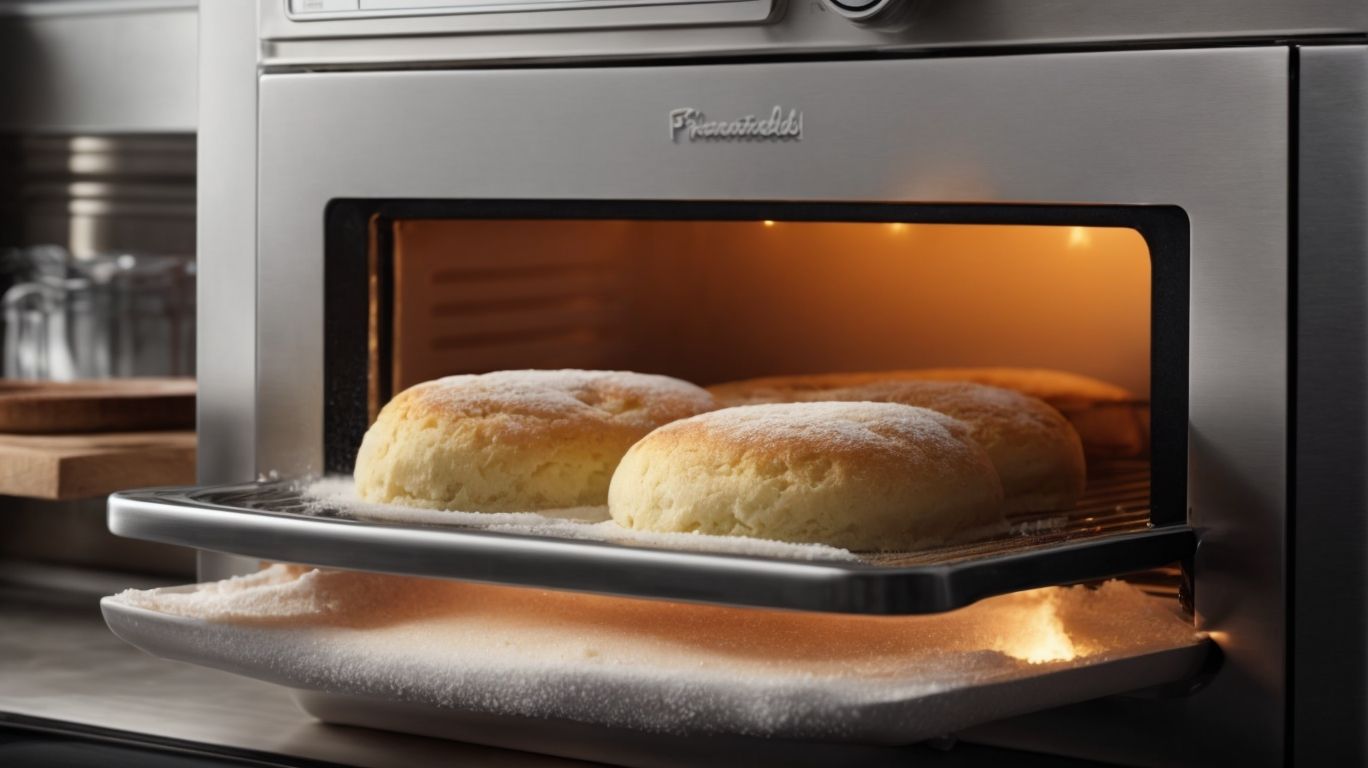How to Bake Bread From Frozen Dough?
Are you a baking enthusiast looking to save time in the kitchen? Look no further than frozen dough! In this comprehensive guide, we will explore everything you need to know about using frozen dough to create delicious bread.
From thawing and proofing to shaping and baking, we’ve got you covered. Get ready to elevate your baking game with our tips for storing, reheating, adding flavor, and achieving that perfect crispy crust.
Let’s dive in and discover the wonders of baking bread from frozen dough!
Key Takeaways:
What is Frozen Dough?
Frozen Dough refers to a convenient option for creating homemade yeast breads without the need to mix and knead the dough from scratch. The process involves preparing the dough in advance, freezing it, and then using it when needed to bake delicious bread with the desired aroma, flavor, and texture.
One of the key advantages of using frozen dough is the preservation of the intricate flavors and smells that develop during the fermentation process of yeast breads. Freezing the dough at the right stage locks in these delicate nuances, ensuring that your baked goods have that distinctive homemade taste. Not only does frozen dough save time, but it also guarantees consistent quality, as the structure and texture of the bread remain intact. This means you can enjoy freshly baked bread without compromising on its deliciousness.
Why Use Frozen Dough?
Using Frozen Dough offers the advantage of convenience and time-saving, as it eliminates the need for preparing dough from scratch. Frozen Dough often comes in well-packaged forms with detailed nutrition information and ingredients list, ensuring a hassle-free baking experience.
One of the main benefits of opting for Frozen Dough is that it allows both seasoned bakers and beginners to skip the time-consuming process of kneading and waiting for dough to rise, cutting down prepping time significantly. The presence of preservatives in Frozen Dough not only helps to prolong its shelf life but also ensures that the dough retains its freshness and flavor when baked. The carefully designed packaging of Frozen Dough keeps it protected from freezer burn and contamination, preserving its quality until you are ready to use it.
Preparing the Frozen Dough
Preparing Frozen Dough involves thawing the dough in the refrigerator, allowing it to rise, shaping it as desired, baking it to perfection, and finally cooling it before serving. This process ensures that the bread rises properly and maintains its intended texture.
-
Thawing the dough in the refrigerator is a crucial step, as it allows the yeast to reactivate slowly, resulting in a better texture and flavor.
-
Rising the dough at room temperature after thawing helps in developing the gluten structure, leading to a light and airy end product.
-
Shaping the dough can vary from traditional loaf shapes to creative braids or rolls, enhancing both the visual appeal and texture.
-
Baking the dough at the right temperature and time ensures that it cooks evenly and develops a golden crust.
-
Allowing the baked bread to cool properly prevents it from becoming soggy and makes slicing easier.
How to Thaw Frozen Dough?
Thawing Frozen Dough in the refrigerator is a crucial step to ensure proper dough rise and texture in the final baked bread. Allow the dough to slowly thaw in the fridge overnight or as per package instructions for the best results.
When thawing Frozen Dough in the refrigerator, it’s essential to maintain a cool temperature to prevent premature rising or potential bacterial growth. By placing the dough in the coldest part of the fridge, you can ensure a consistent and safe thawing process. Different bread dough types may require varying thawing times, so always refer to the specific instructions provided by the manufacturer. Covering the dough with plastic wrap or a damp cloth can help retain moisture during the thawing process, resulting in softer and more pliable dough for shaping and baking.
How to Proof Frozen Dough?
Proofing Frozen Dough involves activating the yeast to ensure proper fermentation and rise. Kneading the dough gently after thawing and allowing it to proof in a warm environment are essential steps for successful bread baking.
Activating the yeast is a crucial stage in the proofing process. To do this, you can dissolve the yeast in warm water or milk along with a pinch of sugar. The yeast reacts to the sugars, producing carbon dioxide, which allows the dough to rise. Proper kneading techniques help develop the gluten in the dough, giving it structure and elasticity.
To create an ideal environment for proofing, cover the dough with a damp cloth or plastic wrap to retain moisture. Placing it in a draft-free, warm area, like an oven with the light on, promotes fermentation. The correct proofing time varies depending on the recipe but is essential for developing the flavors and textures that make bread truly delicious.
How to Shape Frozen Dough?
Shaping Frozen Dough into desired forms like loaves or rolls can be done by hand or using a bread maker for convenience. Adding a butter glaze before shaping can enhance the flavor and appearance of the baked bread.
When shaping frozen dough by hand, divide the dough into equal portions and gently stretch and tuck the edges underneath to create a smooth surface. For loaves, roll the dough into a log and place it in a greased pan. To make rolls, divide the dough into smaller pieces and shape them into balls before arranging them on a baking sheet.
If using a bread maker, follow the manufacturer’s instructions for shaping the dough after it has been proofed. A bread maker can streamline the process and ensure consistent results.
After shaping, a butter glaze can be brushed on top of the dough for a rich and flavorful crust. Simply melt butter and brush it over the surface before baking to add a delicious finish to your homemade bread.
Baking Frozen Dough

Credits: Poormet.Com – Austin Gonzalez
Baking Frozen Dough to perfection requires precise oven settings, monitoring the baking time, and using the right ingredients as per the recipe. Following these steps ensures that the bread is baked evenly and with the intended flavor.
In terms of oven settings, preheating the oven to the correct temperature is crucial. The ideal temperature will help the dough rise properly without burning the crust. Paying attention to the baking time ensures that the bread is not undercooked or overdone, resulting in a perfect texture.
Ingredient measurement is equally important; even a slight deviation can affect the taste and texture of the final product. Following the recipe instructions diligently guarantees that the dough will have the right balance of flavors and consistency, producing a delectable outcome every time.
How to Preheat the Oven?
Preheating the oven is a crucial step before baking Frozen Dough to ensure even heat distribution and proper rise. Set the oven to the recommended temperature as per the recipe instructions for optimal baking results.
Preheating plays a significant role in ensuring that the dough receives consistent heat from all sides, allowing it to rise uniformly and achieve the desired texture and flavor. When the oven is not preheated properly, the dough may not bake evenly, resulting in an undercooked or overcooked final product. By following the recommended oven temperature, you create an ideal environment for the dough to expand and develop its flavors while maintaining its structure.
How to Bake Frozen Dough?
Baking Frozen Dough involves placing the shaped dough in the preheated oven and following the recommended baking time. Monitor the baking process to achieve the desired golden crust and fully cooked interior.
Once the dough is positioned in the oven, remember to set the timer diligently. This step is crucial as it ensures that the dough bakes evenly and does not under or overcook. Timing is everything in baking, striking that delicate balance between a crisp outer layer and a moist, fluffy center.
It’s essential to regularly check on the progress of baking, as variations in ovens can affect the outcome. A watchful eye will guard against any mishaps and help achieve that perfect texture and flavor.
Adjusting the oven temperature or rotating the pan can also be necessary for even baking.
How to Check if the Bread is Done?
Checking if the bread made from Frozen Dough is done involves inserting a toothpick or thermometer into the center to ensure it comes out clean or reaches the recommended internal temperature. Allow the bread to cool before slicing and serving.
When using the toothpick method, gently insert a toothpick into the center of the loaf. If it comes out without any doughy residue sticking to it, the bread is ready.
Alternatively, when using a thermometer, ensure it reaches an internal temperature of around 190-200°F (88-93°C) for most types of bread.
Once the bread is fully baked, remove it from the oven and place it on a wire rack. Let it cool for at least 30 minutes before cutting into it.
Tips for Baking Frozen Dough

Credits: Poormet.Com – Harold Ramirez
To enhance the baking experience with Frozen Dough, consider storing it properly, reheating with care, adding flavorful ingredients, preventing sogginess, and achieving a crispy crust for delightful bread every time.
When storing Frozen Dough, ensure it is tightly wrapped to prevent freezer burn and maintain its freshness.
- For reheating, thaw the dough in the refrigerator overnight to allow it to rise slowly and retain its texture.
- When adding flavors, herbs, cheeses, or spices can elevate the taste profile of the bread.
- To prevent sogginess, bake the dough on a preheated surface or use a baking stone for a crispy bottom.
- For a crispy crust, mist the dough with water before baking and create steam in the oven to promote crust development.
How to Store Frozen Dough?
Storing Frozen Dough involves freezing it in airtight containers or bags to maintain freshness. When ready to bake, follow proper thawing techniques, either in the refrigerator or using a bread maker for convenient usage.
It is crucial to ensure that the airtight containers or bags are sealed properly before placing the dough in the freezer. This not only helps in preserving the dough’s quality but also prevents any freezer burn.
When thawing in the refrigerator, place the dough in its container on a plate or tray to catch any drips. Alternatively, if using a bread maker for thawing, be mindful of the dough’s temperature for optimal results.
How to Reheat Frozen Bread?
Reheating Frozen Bread can be done in a variety of ways, such as using cabin heat in a vehicle or an inverter for on-the-go warmth. Ensure even reheating to maintain the bread’s texture and flavor.
Another option to reheating frozen bread is to use a conventional oven or toaster oven.
Preheat the oven to 350°F (175°C), then wrap the bread in foil to prevent excessive drying. Place it in the oven for about 10-15 minutes until it is thoroughly heated.
You can also use a microwave for a quicker option, but be cautious as it can make the bread soggy if not monitored properly. Wrap the bread in a damp paper towel and heat in short intervals to achieve even reheating.
How to Add Flavor to Frozen Dough?
Enhancing the flavor of Frozen Dough is possible by incorporating various ingredients such as herbs, spices, or specialty flours like King Arthur Flour.
Experiment with different flavor combinations to customize the bread to your taste preferences.
Adding herbs like rosemary or thyme can infuse a fragrant aroma into the dough, while spices such as cinnamon or nutmeg can create a warm and inviting flavor profile.
For a more sophisticated touch, consider using premium flours like King Arthur Flour, known for its exceptional quality and performance in baking.
By mixing and matching different ingredients, you can unleash your creativity and come up with unique bread varieties that will delight your taste buds.
How to Prevent Bread from Becoming Soggy?
Preventing Frozen Bread from becoming soggy involves allowing it to cool completely on a wire rack after baking to maintain a crisp crust. Avoid covering hot bread or storing it in sealed containers to prevent moisture buildup.
Properly cooling your freshly baked bread is crucial in ensuring that the crust retains its desired texture. Placing the bread on a wire rack allows for air circulation around the loaf, preventing trapped steam from turning the crust soggy.
- When bread is hot, enclosing it in plastic wrap or sealing it in a container traps steam, leading to condensation and a loss of crispiness.
- It is advisable to wait until the bread is completely cooled before transferring it to any storage option.
Stay mindful of these steps to enjoy your frozen bread as if it were just out of the oven!”
How to Get a Crispy Crust on Frozen Bread?
Achieving a crispy crust on Frozen Bread can be accomplished by following no-knead techniques that enhance the texture and appearance of the crust. Implement proper baking methods and temperature control for optimal crispiness.
One key method to enhance the crunchiness of the crust is to preheat the oven adequately before baking the Frozen Bread. This initial burst of high heat helps in creating that desirable crispy exterior while keeping the inside soft. Additionally, applying steam during the initial stages of baking can work wonders for achieving the perfect crust texture by promoting crust formation while allowing the dough to expand properly. Experimenting with different baking times and temperatures can also lead to variations in crust thickness and crunchiness.
Frequently Asked Questions
What is the best way to thaw frozen bread dough before baking?
The best way to thaw frozen bread dough is to place it in the refrigerator overnight. This allows for a slow thaw, preventing the dough from becoming too soft.
Can I bake frozen bread dough without thawing it first?
Yes, you can bake frozen bread dough without thawing it first. However, the baking time may need to be extended by a few minutes.
How can I ensure the bread dough rises properly after being frozen?
To ensure proper rising, make sure the frozen bread dough is completely thawed and at room temperature before shaping and proofing. This may take a few hours.
Can I freeze homemade bread dough?
Yes, homemade bread dough can be frozen. Simply wrap it tightly in plastic wrap or place it in a freezer-safe bag before freezing.
What is the best way to store leftover baked bread made from frozen dough?
Leftover baked bread made from frozen dough can be stored in an airtight container at room temperature for up to 2 days. For longer storage, wrap it tightly in plastic wrap and freeze.
Can I add additional ingredients to frozen bread dough before baking?
Yes, you can add additional ingredients such as herbs, cheese, or nuts to frozen bread dough before baking. Just make sure to incorporate them well into the dough before shaping.

